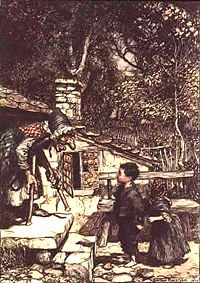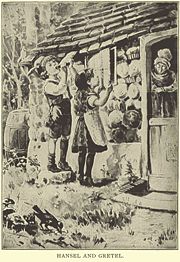Hansel and Gretel
| Hansel and Gretel | |
|---|---|
 |
|
| Artwork by Arthur Rackham, 1909 | |
| Folk tale | |
| Name: | Hansel and Gretel |
| Data | |
| Aarne-Thompson Grouping: | 327A |
| Country: | Germany |
| Published_In: | Grimm's Fairy Tales |
| Related: | The Lost Children |
Hansel and Gretel (German: ''Hänsel und Gretel'') is a fairy tale of Germanic origin, adapted by the Brothers Grimm and earlier by Giambattista Basile.
Contents |
Plot synopsis
Hansel and Gretel are the children of a poor woodcutter. Fearing starvation, the woodcutter's wife (variably called the children's mother or stepmother) convinces him to lead the children into the forest and abandon them there. Hansel and Gretel hear her plan and gather white pebbles from the front garden to leave themselves a trail home. After their return, their mother clears all the pebbles from the front garden after she found out the children used them to find their way back so she convinces the woodcutter to abandon them again due to food shortages further in the forest so they cannot find their way back; this time however, they can only leave a trail of breadcrumbs. Unfortunately, the various animals of the woods eat their trail of breadcrumbs, causing Hansel and Gretel to become lost. (The story up to this point is identical to Perrault's Le Petit Poucet.)
Lost in the forest, they find a house made of ginger bread and candies, with sugar windows. Unable to resist, they begin to eat it. The inhabitant of the house, an old woman, invites them in and prepares a feast for them. The table is covered with candy, nuts, pancakes and other sweets. The woman, however, is a witch who has built the house to entice children to her, so that she may fatten and eat them. She locks Hansel in a cage, and makes Gretel her servant. While she prepares to cook Hansel, she orders Gretel to fetch her candies and fats to force feed Hansel. Unable to do anything, Gretel weeps bitterly and does as she is told. In the cage, Hansel finds a thin bone from his meals. When the witch tells Hansel to stick out his finger (so she can tell if he is fat enough to eat), he deceives her by sticking out the bone instead. The woman has poor eyesight and is very old, and thus cannot see that Hansel's "finger" is actually a bone. Days pass by, but the witch cannot perceive how fat Hansel is getting. She gets frustrated and decides to eat him anyway, "be he fat or lean". She tells Gretel to climb into an oven to be sure it is ready to bake, but Gretel guesses that the witch intends to bake her, and tricks the witch into climbing into the oven, closing it behind her.
Taking jewels from the witch's house, the children set off for home to be reunited with their father. After reuniting with their father and finding out that their stepmother has died, they all live happily ever after.
Analysis

The tale from the Brothers Grimm was meant to be a pleasant fable for middle-class consumers of the 19th century; the original however was probably an admonishment of the hardships of medieval life.[1] Because of episodes of famine, war, plague and other reasons, abandoning children in the woods to die or fend for themselves was not unknown, in particular during the crisis of the Late Middle Ages. Many critics have posited that the tale likely stemmed from historical instances of abandonment caused by famine; see the works of Jack Zipes and Maria Tatar for example,[2] with the obvious message of not accepting the seeming generosity of strangers.
In the first editions of the Grimms' collection, there was no stepmother; the mother persuaded the father to abandon their own children. This change, as in Snow White, appears to be a deliberate toning down of the unpleasantness, for children.[3]
That the mother or stepmother happens to die when the children have killed the witch has suggested to many commentators that the mother or stepmother and the witch are, in fact, the same woman, or at least that an identity between them is strongly hinted at.[4] Indeed, a Russian folk tale exists in which the evil stepmother (also the wife of a poor woodcutter) asks her hated stepdaughter to go into the forest to borrow a light from her sister, who turns out to be Baba Yaga - who, though her house is anything but enticing, is also a cannibalistic witch. Besides the stories highlighting the endangering the children - and indeed their cleverness - they have in common a preoccupation with food: the stepmother to avoid hunger, and the witch with her house built of food and her desire to eat the children.[5]
The tale is Aarne-Thompson type 327A.[6] Another tale of this type is The Lost Children.[7] Although they are not classified under this type, the Brothers Grimm identified the French Finette Cendron and Hop o' My Thumb as parallels to the story.[8] The basic elements are found in tales throughout the world, although their simplicity makes it hard to tell whether a given instance is a borrowing or an independent invention.[9] At the end everyone lives happily ever after.
Popular culture
- In Germany, there is a foundation set up to help abused children called the 'Hänsel+Gretel' foundation. German cross country skier Claudia Künzel donated her 4 x 5 km relay gold medal from the 2002 Winter Olympics in Salt Lake City to benefit the foundation in the summer of 2007.[10]
See also
- Molly Whuppie
- The Witch
- Vasilissa the Beautiful
- Foundling-Bird
- Frau Trude
- Buttercup
- The Golden Stag
Notes
- ↑ George Gordon Coulton (1989). The Medieval Village. Page 326
- ↑ Maria Tatar, The Hard Facts of the Grimms' Fairy Tales, p49, ISBN 0-691-06722-8
- ↑ Maria Tatar, p 45, The Annotated Classic Fairy Tales, ISBN 0-393-05163-3
- ↑ Max Lüthi, Once Upon A Time: On the Nature of Fairy Tales, p 64, Frederick Ungar Publishing Co., New York, 1970
- ↑ Maria Tatar, p 57, The Annotated Classic Fairy Tales, ISBN 0-393-05163-3
- ↑ Heidi Anne Heine, "Tales Similar to Hansel And Gretel"
- ↑ Paul Delarue, The Borzoi Book of French Folk-Tales, p 365, Alfred A. Knopf, Inc., New York 1956
- ↑ Maria Tatar, The Annotated Brothers Grimm, p 72 ISBN 0-393-05848-4
- ↑ Stith Thompson, The Folktale, p 36-7, University of California Press, Berkeley Los Angeles London, 1977
- ↑ FIS Newsflash 135. July 11, 2007
External links
- Project Gutenberg e-text
- SurLaLune Fairy Tale Pages: The Annotated Hansel and Gretel. Includes an annotated version, literary history, public domain artwork, modern analysis, bibliography and book gallery.
- Original versions and psychological analysis of classic fairy tales, including Hansel and Gretel